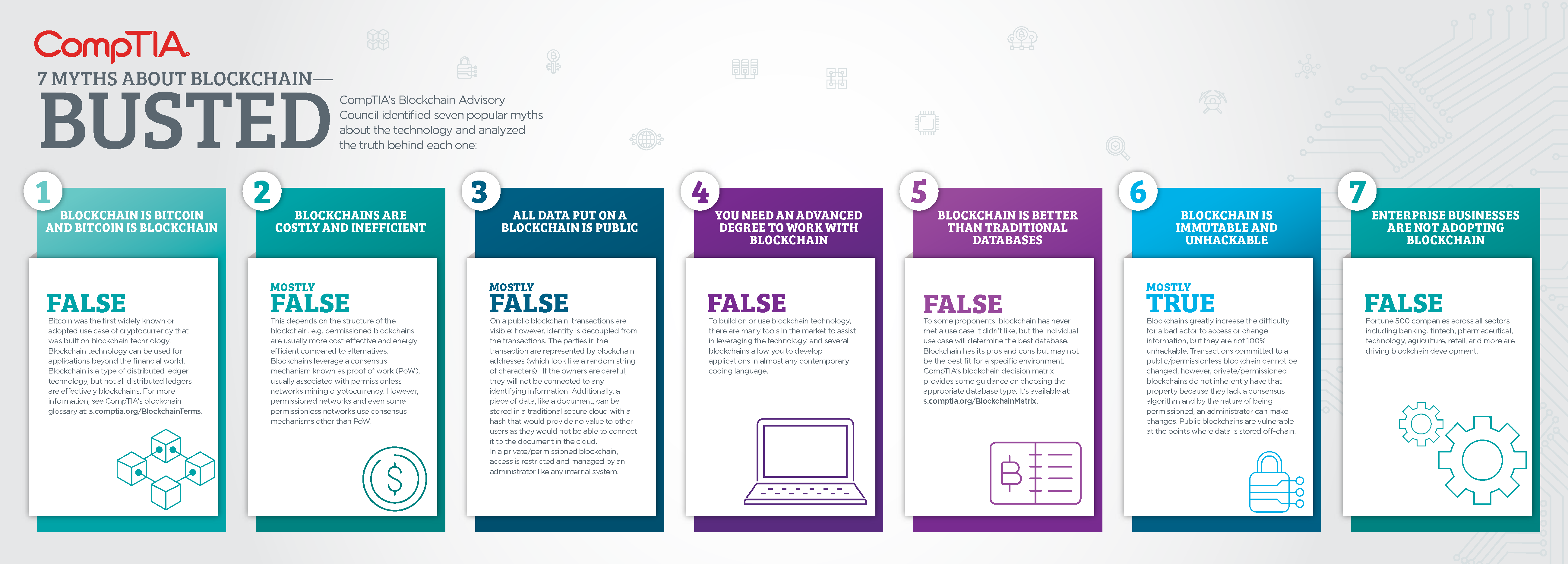Blockchain isn’t Bitcoin, it’s not inefficient and enterprises of all sizes can implement solutions leveraging the technology. These, and several other myths you may have heard about blockchain, aren’t necessarily true. To help set the record straight, CompTIA’s Blockchain Advisory Council identified seven popular notions about the technology and analyzed the truth behind each one:

False. Bitcoin was the first widely known or adopted use case of cryptocurrency that was built on blockchain technology. Blockchain technology can be used for applications beyond the financial world. Blockchain is a type of distributed
ledger technology, but not all distributed ledgers are effectively blockchains. For more information, see CompTIA's blockchain glossary at:
s.comptia.org/BlockchainTerms.
Mostly False. This depends on the structure of the blockchain, e.g. permissioned blockchains are usually more cost-effective and energy efficient compared to alternatives. Blockchains leverage a consensus mechanism known as proof of work (PoW), usually associated with permissionless networks mining cryptocurrency. However, permissioned networks and even some permissionless networks use consensus mechanisms other than PoW.
Mostly False. On a public blockchain, transactions are visible; however, identity is decoupled from the transactions. The parties in the transaction are represented by blockchain addresses (which look like a random string of characters). If the owners are careful, they will not be connected to any identifying information. Additionally, a piece of data, like a document, can be stored in a traditional secure cloud with a hash that would provide no value to other users as they would not be able to connect it to the document in the cloud. In a private/permissioned blockchain, access is restricted and managed by an administrator like any internal system.
False. To build on or use blockchain technology, there are many tools in the market to assist in leveraging the technology, and several blockchains allow you to develop applications in almost any contemporary coding language.
False. To some proponents, blockchain has never met a use case it didn’t like, but the individual use case will determine the best database. Blockchain has its pros and cons but may not be the best fit for a specific environment. CompTIA's blockchain decision matrix provides some guidance on choosing the appropriate database type. It's available at: s.comptia.org/BlockchainMatrix.
Mostly True. Blockchains greatly increase the difficulty for a bad actor to access or change information, but they are not 100% unhackable. Transactions committed to a public/permissionless blockchain cannot be changed, however, private/permissioned blockchains do not inherently have that property because they lack a consensus algorithm and by the nature of being permissioned, an administrator can make changes. Public blockchains are vulnerable at the points where data is stored off-chain.
False. Fortune 500 companies across all sectors including banking, fintech, pharmaceutical, technology, agriculture, retail, and more are driving blockchain development.